Chargers' Donald Parham Jr. on injury: 'A life-flashing-before-your-eyes kind of thing'
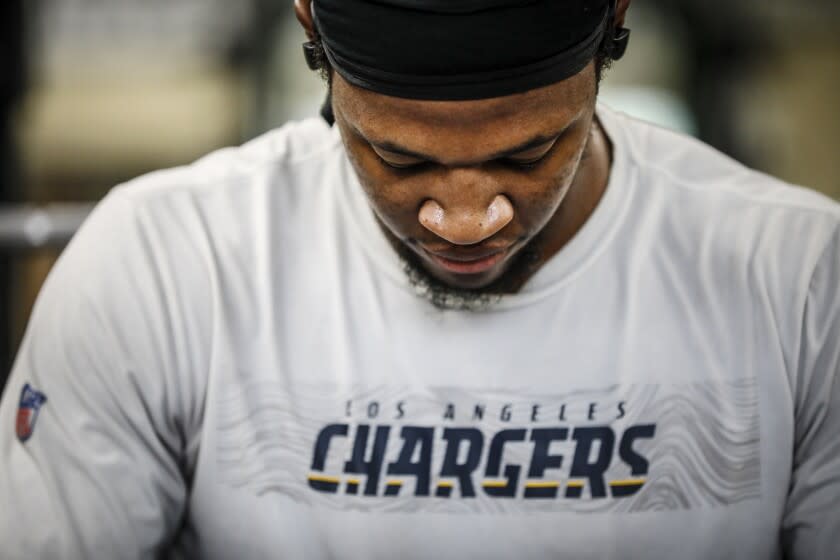
He re-emerged here, on a small set of metal bleachers, next to an empty practice field, 2,500 miles from SoFi Stadium.
On a windy and warm spring afternoon, Donald Parham Jr. sat alone with a visitor sent to chronicle his comeback.
Nearly four months had passed since Parham disappeared from view under much brighter lights. A national television audience and sellout crowd watched as he was strapped to a stretcher and rolled out of the most frightening scene of the 2021 NFL season.
The Chargers tight end remembers all of it: the touchdown pass slipping from his grip, his head snapping back onto the turf, his body stiffening and ignoring the pleas to move even as the tremors shook his otherwise rigid arms.
“I was just thinking about if I’ll ever play again,” Parham said. “Really thinking about everything else I still wanted to do. It was a life-flashing-before-your-eyes kind of thing. Was it all going to be taken away from me in that instant?”

Watching the game from the family home in Lakeland, Fla., Felicia Parham said she and her husband, Donald Sr., were pulled from their seats and found themselves pacing. And praying. Mostly praying.
On their TV came a close-up of their son’s face. His eyes were shut, and he wore no discernible expression.
Just moments earlier, Felicia said, she had been bouncing on the couch, shouting at the TV and rooting on her firstborn — just as always — much to the concern of the family’s anxious, barking Pomeranian, Cash.
“All of a sudden,” Felicia said, “everything went on pause.”
Before long, she was on the phone, first with her son’s girlfriend. Then with his agent. Then his girlfriend again. Then his agent’s secretary. Travel plans had to be made — and right now.
A few sleepless hours later, Felicia was headed to the airport in Tampa for a 6 a.m. nonstop to LAX, an uneasy 5½ hours for a mother to do little more than think.
Brittany McGee, Parham’s girlfriend, picked her up and they drove to Harbor-UCLA Medical Center.
At that blurry-eyed moment, Parham’s future was very uncertain. He had talked to his mother on a video call hours earlier from the hospital, had told her he would be OK and assured he would play again. But Felicia needed to see for herself.
'I was sick to my stomach. My husband was sick to his stomach. I immediately packed my bags. I had to see him.'
Felicia Parham, mother of Chargers' Donald Jr., on watching her injured son on TV in her Florida home
By the end of the weekend, everyone knew that, yes, Parham was going to be fine. But not many know the details of a situation so sobering that today Parham has no memory of that video call.
What follows is a collection of those details, an account that began with a quiet conversation on a small college campus.
Stetson University is a private school of roughly 4,300 students located among mossy oaks and waltzing palms about 40 miles north of Orlando.
Parham played here from 2015-18, two plaques displayed in the athletics building commemorating a final season in which he was the NCAA per-game leader in receptions and yards.
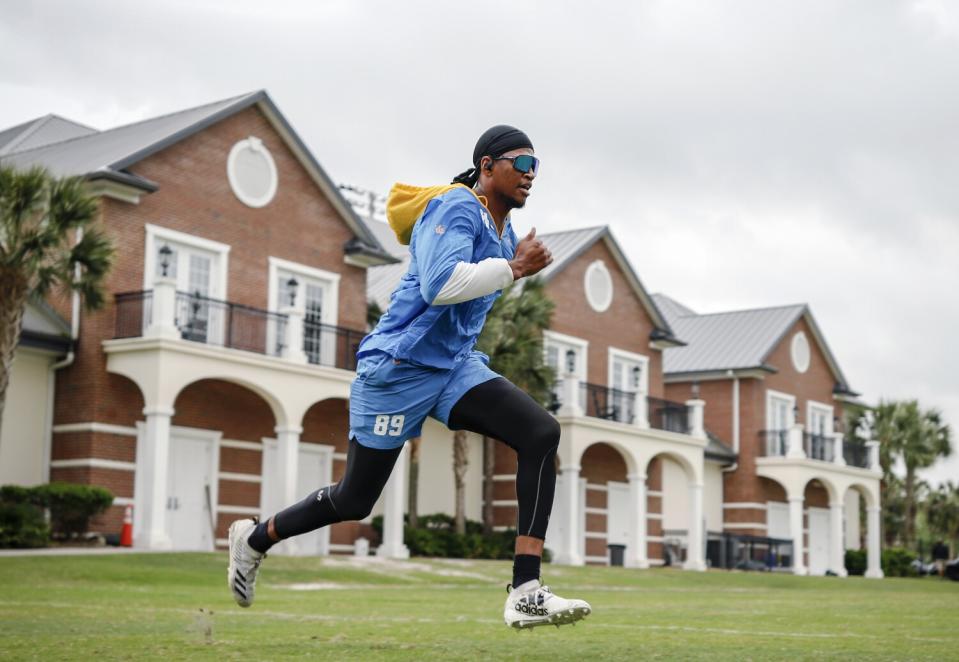
This is where he first truly stood his tallest, where he grew those final two inches to reach 6-foot-8, fulfilling forecasts of the pediatricians who had repeatedly told the Parhams their son was, size-wise, “off all the charts.”
Parham is a student here again, working toward a communications degree he hopes to complete in the spring of 2023.
His picture hangs along the fence that encircles the practice field. A wall inside the football offices will soon feature another giant likeness, one of Parham in action as a Charger.
“He has lived up to all the expectations and become an overwhelming figure for this program and our league,” said head coach Brian Young, who was the defensive coordinator during Parham’s time as a Hatter. “Donald is Stetson.”
State Road 44 passes next to campus and is dotted by nearby businesses with names such as Dolly’s Olde Time Tavern, Lucky Ducky Arcade and DeLand Feed & Pet Supply.
To be sure, this is not a road that traditionally leads to the NFL. Parham and former teammate Donald Payne are the only Stetson players to make it to the league since the school reinstated football in 2013 after a half-century hiatus.
In that sense, the horrific scene in Inglewood on the night of Dec. 16 was another twist on a path that has seen Parham overcome going undrafted, failing to make it with a handful of NFL teams and ending up in the now-suspended XFL before the Chargers signed him.
“He’s already had a detour coming out of the XFL,” Payne said. “He worked his way up from that detour to make it to the biggest stage ever, catching touchdown passes on ‘Monday Night Football.’ Those of us who know Donald know he’s got this, 1,000%.”
That night, Kansas City won the coin toss and deferred, giving the Chargers the ball to start a matchup the NFL couldn’t have scripted better. Young superstar quarterbacks Justin Herbert and Patrick Mahomes would battle with the AFC West lead going to the winner.
Set up by a 75-yard kickoff return by Andre Roberts, Herbert and his offense quickly moved to the Chiefs’ five-yard line, where it was first-and-goal. Three incompletions brought fourth down and coach Brandon Staley’s decision to go for it.
“A routine play,” Parham said. “We ran it a few times in practice. We were comfortable with it.”
Lined up in a standing position on the right side, Parham cut inside between two linebackers, working his way toward the back of the end zone, where he ran away from safety Tyrann Mathieu as fellow safety Daniel Sorensen closed in.
He went airborne lunging for Herbert’s spiral and landed on his back before coming to rest on his right side, Parham’s body frozen with his arms extended in front of him and bent upward at the elbows in what experts call the fencing response, a condition that can follow trauma to the brain.
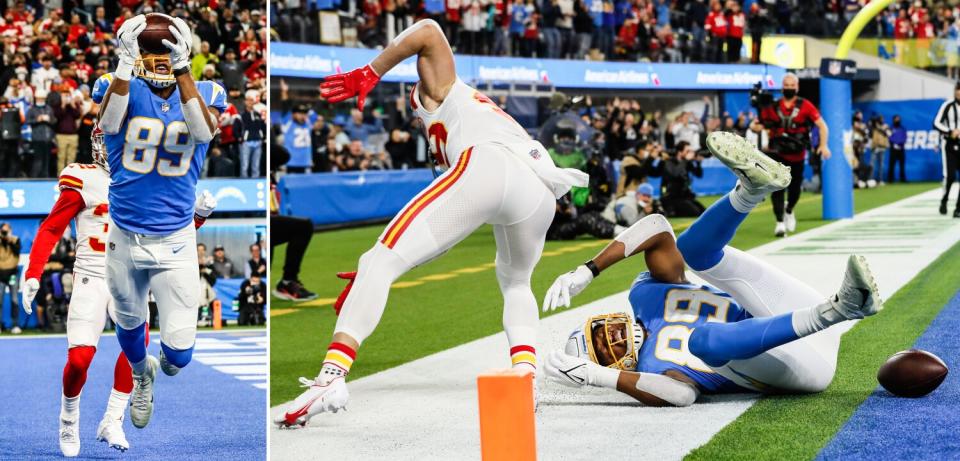
Running back Austin Ekeler arrived to help Parham to his feet before realizing something was wrong. Medical personnel were summoned and rushed from the Chargers’ sideline.
Many of Parham’s teammates began to gather around him. Tight end Stephen Anderson knelt nearby, dropping his head. A TV camera caught linebacker Drue Tranquill staring solemnly from one knee.
With this being a Thursday night, there were no other NFL games being played. The next day, it would be determined that 18 million people — the second-most to watch the Chargers all season — were tuned in.
“It was all very traumatic,” Felicia said. “Then to be so far away and not be able to … I was sick to my stomach. My husband was sick to his stomach. I immediately packed my bags. I had to see him.”
Amid the scrambling, she sent a text message to a group of friends she called “prayer warriors,” seeking support.
Payne, who also was watching the game, said his ongoing group chat “started blowing up, you know, praying for him. It was definitely something intense.”
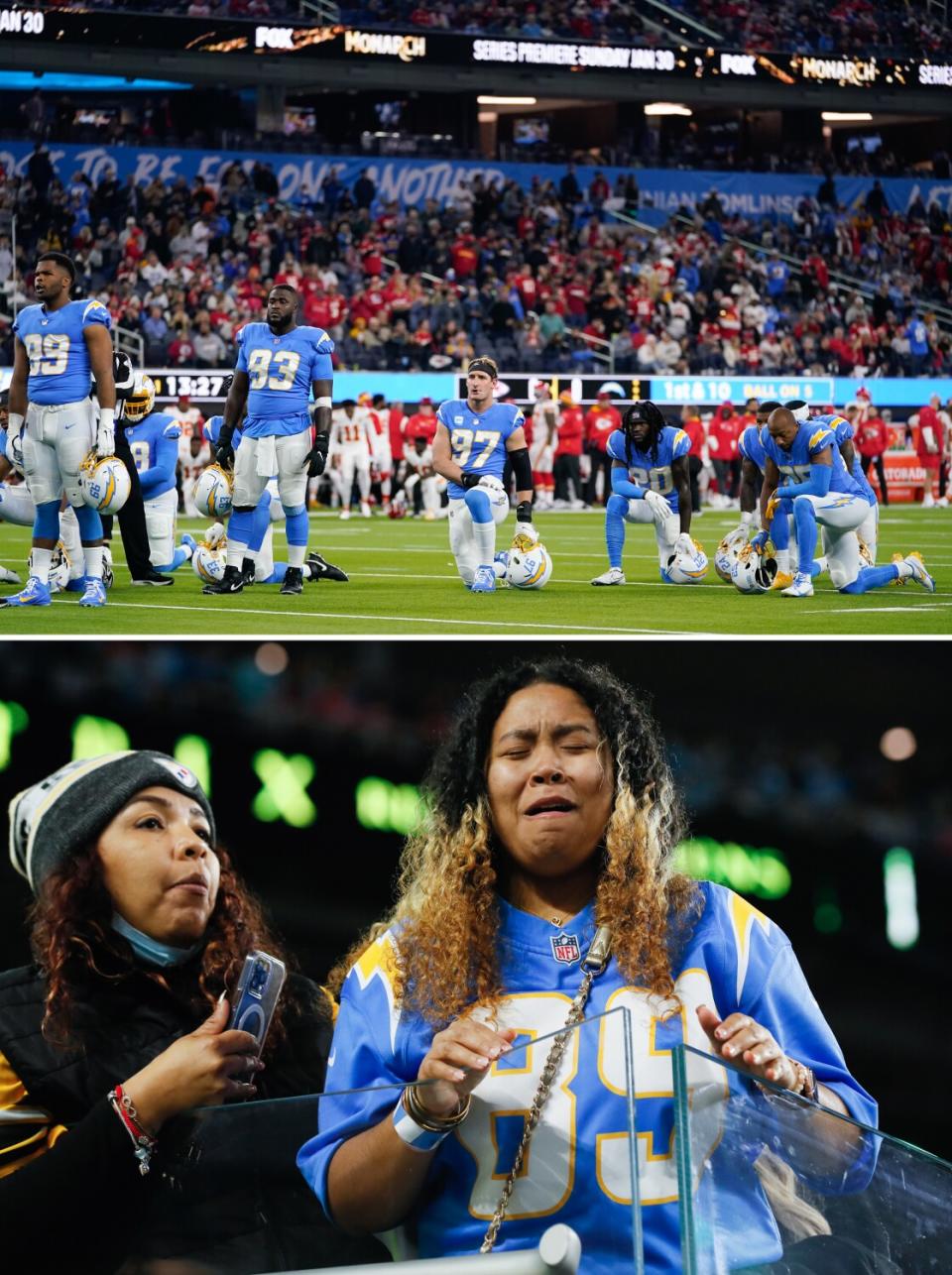
It was something familiar, as well. In August 2017, a sophomore linebacker named Nick Blakely collapsed at a Stetson practice and later died. An autopsy revealed that he had an enlarged heart.
“The Stetson community already had something along these lines happen,” Payne said. “So to be in another situation where it was one of our own who was down made it even scarier.”
Only 93 seconds into the most-anticipated of games, the mood inside SoFi Stadium struggled to recover, the image of Parham being wheeled out through an end-zone tunnel powerful and lasting.
And then his arms — restrained but still trembling in a way that was visible to all — caused wild speculation from people who couldn’t possibly know the specifics.
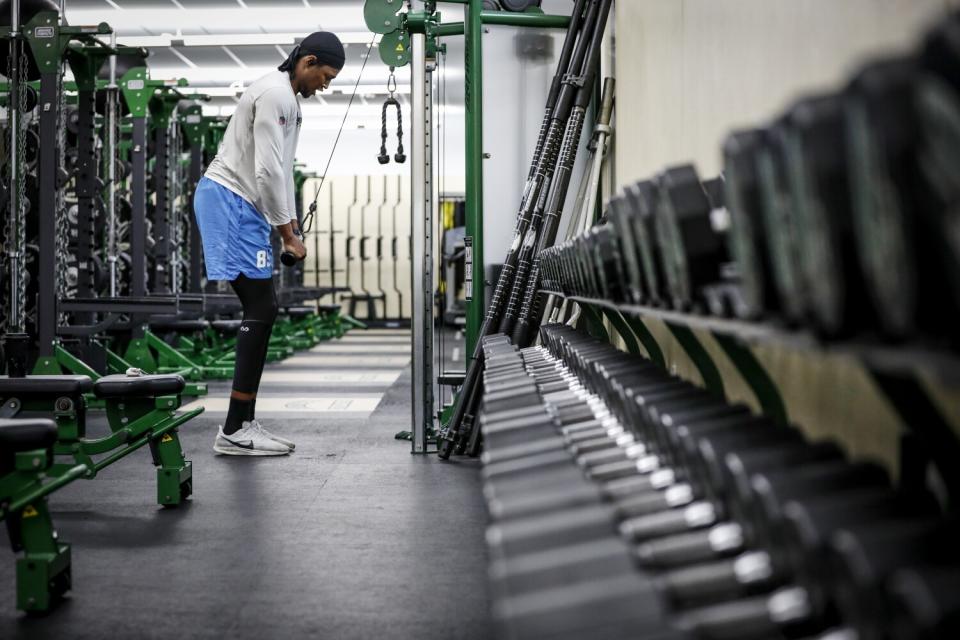
“It was extremely scary,” Felicia said. “To see him shaking, I didn’t know what that was. So I’m checking social media and I’m seeing things about people counting him out, talking about him being paralyzed.
“I was so disheartened to see people say these things. They’re not thinking about how he has a family. How are they saying such things when he’s got a mom and a dad and a brother and others who love him?”
Parham said he was intubated in the ambulance en route to the hospital and remembers nothing more until awakening early Friday. He started by trying to wiggle his fingers and called his body’s immediate response “a blessing.”
'They were freaking out, almost like they were seeing a ghost.'
Donald Parham Jr., on teammates' reactions when he returned to the Chargers facility after his injury.
He underwent a variety of scans and other tests, all the signs encouraging. Doctors repeatedly checked Parham’s motor skills, those results similarly positive.
By mid-morning, the Chargers were able to provide an official update, announcing on Twitter that Parham had been diagnosed with a concussion and would be leaving the hospital soon.
Later that day, he posted a photo of his right hand flashing the thumbs-up and a proclamation that he’d return better than ever. The tweet was liked more than 80,000 times.
“The doctors assured me nothing was wrong in terms of paralysis or anything like that,” Parham said. “My first thought was, ‘OK, well I need to get out of here.’ That was the biggest thing, getting out of there and getting back to reality.”
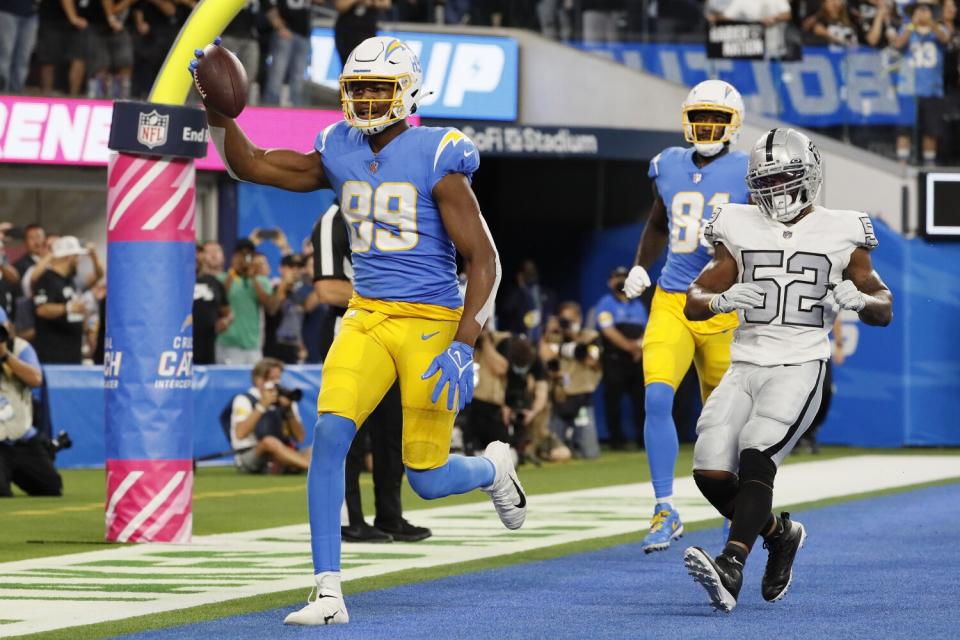
He ended up spending three nights at Harbor-UCLA, his mom and girlfriend sleeping in his room on chairs, Brittany’s pulled up next to his bed so the two could hold hands.
Around noon Sunday, they all left the hospital together.
A few days later, Parham walked into the Chargers’ Costa Mesa facility, headed toward the locker room and was greeted by a series of friendly but disbelieving faces.
“They were freaking out, almost like they were seeing a ghost,” he said. “It was kind of funny. A lot of the guys were like, ‘Just go home, bro. You don’t have to be here.’ I was like, ‘Oh, OK, my bad.’ And I left.”
He wanted to return as quickly as possible, Parham said, because playing in the NFL has been his truest passion for years. He also wanted to prove he was tougher than even the scariest of career-threatening incidents.
Parham has a very practical, measured approach looking back on something that has so much emotion attached.
“I didn’t have to dive,” he said. “I could have possibly stayed on my feet or slid almost like a baseball player. But it happened. I have to learn from it and grow from it.
“Really, it’s just a learning experience. Nothing more now. I gotta protect myself. That’s just my character. I’m pretty even-keeled, level-headed. I’m always able to re-evaluate and reassess and go from there.”
After missing the final three games of the season, Parham was medically cleared in early February. He said he expects to rejoin his teammates for offseason workouts in May, after the semester ends at Stetson. The first day of offseason workouts for players is Monday.
His want to play has not been diminished, he promised, adding that he anticipates no issues the next time he’s hit or takes a hard or awkward tumble. He said he never thinks about the play, unless someone asks about it. He called the whole scene “an afterthought.”
Football is “just what we do,” Parham explained, his father having played running back at Albany State and his little brother, Donovan, now a linebacker at Robert Morris.
As for those tremors, Parham said no one has been able to provide a specific reason.
“One doctor explained it as having seizure-like symptoms,” he said. “But they weren’t sure. I saw a specialist and he said they weren’t exactly seizures. No one could really pinpoint it. It was just a reaction to what happened.”
The Chargers’ expectations for Parham will only grow in 2022. At 24, he’s entering his third NFL season and will be part of a tight-end rotation that includes veteran Gerald Everett and 2021 third-round pick Tre’ McKitty.
Parham will be counted upon to stand tall again, this time after taking the most frightening of falls. Following a pause that could have been so much longer, so much worse, a twisting NFL journey will continue.
Recalling the moment she first entered her son’s hospital room, Felicia said she can still feel the relief.
“I was finally able to put my eyes on him and see that he was alert and OK,” she said. “It was, ‘Thank you, Jesus.’ It was great to see him and see that he was Donald. He had stuff wired up to him and all that, but he was Donald.”
They talked about family and about faith, Felicia studying her son’s answers by the word to make sure he was all right.
The subject of the game didn’t really come up, Parham, in fact, admitted he was unaware the Chargers had lost — 34-28 in overtime — until days later.
But there was one thing from the night before he did mention.
“Mom,” Felicia remembered Donald Jr. saying, “I should’ve caught that ball.”
This story originally appeared in Los Angeles Times.

